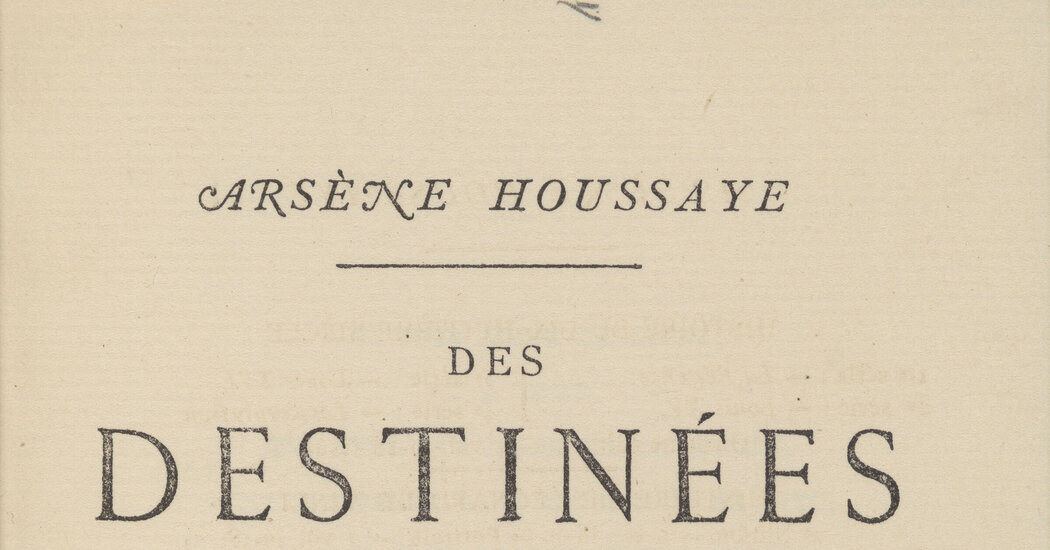The decision to find a “respectful final disposition” for human remains used for a 19th-century book comes amid growing scrutiny of their presence in museum collections.
Of the roughly 20 million books in Harvard University’s libraries, one has long exerted a unique dark fascination, not for its contents, but for the material it was reputedly bound in: human skin.
For years, the volume — a 19th-century French treatise on the human soul — was brought out for show and tell, and sometimes, according to library lore, used to haze new employees. In 2014, the university drew jokey news coverage around the world with the announcement that it had used new technology to confirm that the binding was in fact human skin.
But on Wednesday, after years of criticism and debate, the university announced that it had removed the binding and would be exploring options for “a final respectful disposition of these human remains.”
It’s two centuries old. Who gives a fuck?
Also, Havard has a museum of anatomy. It has things like the skull of Phineas Gage, the man who survived a railroad spike going through his brain. Did Gage volunteer to have his head there? No. His physician donated it.
Why doesn’t Harvard care about those human remains getting a “final respectful disposition?” I’m guessing they’ll argue they have educational value and it’s okay to put human remains on display all the time rather than occasionally, even if the person whose remains they are did not volunteer their body parts to be displayed in a museum.
You don’t need technology to determine if that’s Phineas Gage’s skull. We know it is.
Maybe the difference is that one is a one-of-a-kind medical oddity that was used for research and education and is a fixture in the fields of neurology and psychology, and the other is used for shock value and hazing rituals?
Was Gage’s skull uses for educational purposes that couldn’t be gotten from the information when he was still alive? And was that worth keeping it for well over a century?
Was Gage’s skull used for educational purposes that couldn’t be gotten from the information when he was still alive?
Well, when he was alive, he was still using it. That does kinda put a damper on things, from an educational point of view.
And was that worth keeping it for well over a century?
Honestly, yes. At this point in time, Phineas Gage’s skull and the knowledge gleaned from the study of it has been used to educate thousands upon thousands of people, and then each of those multitudes of educated people went on to improve the lives of thousands and thousands of people. That’s pretty damn good for one single cadaver.
What would they learn from the actual skull that they couldn’t learn from a copy?
For one, veracity. There are lots of unsubstantiated claims similar to this one, just look at the National Enquirer if you’d like an example. This one is real, with verifiable proof, meaning we can use it as a foundation to build more knowledge on top of. Seeing as there is no moral or ethical way to remove someone’s left frontal lobe as a science experiment, it is as close to a case study as we are ever likely to get.
It’s already been verified. So it can be copied. What would the original achieve that a copy would not?
Lots of things were “verified” in 1860. Shit, washing your hands before surgery wasn’t even a common medical practice until the 1870s. The whole point of keeping the original is so that it can stand up to the rigors of modern science and technology.
Technology and knowledge in 150 years will make today’s science seem sincere but laughable, just like today’s science makes 1860 seem sincere but laughable. That’s why you must preserve scientific evidence whenever and wherever you can.
.
I’m just scanning it, so I may be missing things, but it seems to be mostly about indigenous and slave body parts. A quick search reveals that Phineas Gage is not even mentioned. So their thoughts on the matter seem pretty inconsistent.
.
so with the exception of Gage himself the transaction was consensual
Would you say the same if the skull was of a slave?
.
As I said, they would argue Gage’s remains have educational value while the book does not. I do not agree with that. Either both have educational value (and the book arguably does too) so they should be kept, or neither does.
.
The museum is permanently closed and its collections are only available to researchers by appointment only.
Okay, but I’m not sure why that’s any different from showing off the book sometimes or why Gage’s skull is acceptable but this book is not.
There is likely medical knowledge to gain from seeing and understanding Gage’s injury that can help other people with headwounds. Not from the binding of a book.
And that hasn’t been understood in the time period between 1820 and 2024?
And a cast of the skull wouldn’t be just as useful?
It has been understood by some for a long time, but not all. Especially when morbid curiosity is what brings visitors to your museum; without that morbid curiosity, you likely can’t make enough to stay open.
NAGPRA was renegotiated by a Native American Secretary of the Interior and, wouldn’t you know, having diverse voices helps people understand things differently, thus the massive change this year in the way museums display human remains. That’s a good thing. Be mad about the past so it doesn’t happen again, but also be glad that the display stops now.
As for using a cast, I’m sure they have one. But I don’t know if using one affects how medical research is conducted.
Oh yeah ETA: until the advent of the Internet, doctors coming to a place to examine collections of medical specimens was indeed the only way to do certain kinds of medical research.
Fair point. It is more about the psychology of the issue rather than the source material itself. The skull is as is. It was not reworked and processed and it stands as a natural and dark remainder of a common fate. The othet is a purposefully crafted ornament in a not natural context, which says more about the mind of the original crafter than a fact of nature.
That said, why remove it now. If amything that was even more of a curiosity, albeit a morbid one. I would have kept it. I am aware of legends and stories of such cruel local lords of the middle ages that they had a fabled chest decorated with human skin. Just a legend. But that speak of the reputation of a long gone family, doesn’t it?
Edit:
Now, with the binding removed, the text itself will be fully available to view, both at the library and online.
Even without that binding, the text itself still preserves some of its nature. It does make you feel uncomfortble, to know that the original author had done that on purpose.
I think it’s fine to keep both the skull and the book at this point. They were not taken in some sort of colonialist archaeological expedition or anything. I really don’t have a problem with either one. That was what I was trying to get at. Harvard is doing something that is performative. It does not make up for any major wrongdoing because there was no major wrongdoing in either case. Were both unethically procured? Sure. But it’s really not worth worrying about it the same way it would for a skeleton of an ancient Navajo or something.
Oh boy. If they did not speak the three words correctly, shit’s about to hit the fan
deleted by creator








